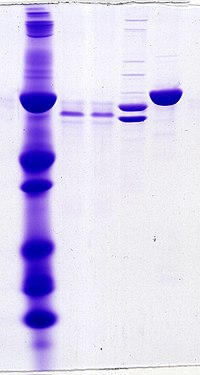
Photo from wikipedia
The dynamics of proteins, which are essential for both folding and function, are known to be strongly dependent on solvent viscosity or friction. However, an increasing number of experiments have… Click to show full abstract
The dynamics of proteins, which are essential for both folding and function, are known to be strongly dependent on solvent viscosity or friction. However, an increasing number of experiments have demonstrated the importance of a contribution to protein dynamics independent of solvent friction. Such ‘internal friction’ has been detected at all stages along the folding reaction. Even in unfolded and intrinsically disordered proteins, internal friction has a large influence, as demonstrated with several experimental techniques and in simulations. However, these methods probe different length- and timescales and have thus been used to illuminate different facets of internal friction in diverse molecular systems. To obtain an integrated and quantitative understanding, we apply the combination of two complementary experimental techniques, theory, and simulations to one system, unfolded protein L. We use single-molecule Forster resonance energy transfer (FRET) to measure the global reconfiguration dynamics of the chain, and photoinduced electron transfer (PET), a contact-based method, to quantify the rate of loop formation between two residues. This combination enables us to probe unfolded-state dynamics on different length scales, corresponding to different parts of the intramolecular distance distributions. Both FRET and PET measurements indicate that internal friction dominates unfolded-state dynamics at low denaturant concentration, and both are in remarkably good agreement with recent large-scale molecular dynamics simulations employing a new water model. The simulations indicate that both hydrogen bond formation and dihedral angle rotation are correlated with the presence of internal friction. Theoretical models of polymer dynamics allow us to quantitatively relate the contribution of internal friction in the two types of experiments with simulations and thus provide a coherent picture of internal friction in unfolded proteins.
Journal Title: Biophysical Journal
Year Published: 2017
Link to full text (if available)
Share on Social Media: Sign Up to like & get
recommendations!